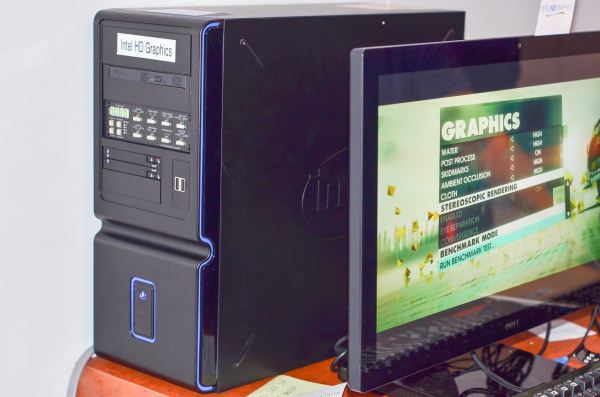Guest from the Future - Integrated Graphics (Intel GPU) at Intel Haswell

I will start with a message for those who did not know, and a reminder for everyone else - according to the testimony of an incorruptible statistics calculation script (authorship saul ), the most popular 2012 blog post from Intel turned out to be “ Mind Games. We deal with Intel HD Graphics. And play? " To date, it has been viewed more than 70,000 times, which is four and a half times higher than the average for such articles. Which suggests that if the Intel GPU has such an interesting present, then the near future should also be interesting.
This post talks about the features of Intel HD Graphics (directly graphics, media, as well as Display Port), integrated into the Intel CPU codenamed “Haswell”, which is coming out in 2013, and also checks the assumption of reader interest.
So, Haswell, the 4th generation of Intel Core microarchitecture CPU, which completes the "-so" for Ivy Bridge "tick", 22-nm manufacturing technology. The processor has not yet been released, but quite a lot is already known about its features, and, in particular, about the integrated GPU. So, Intel engineers talked about this in September 2012 at the Intel Developer Forum in San Francisco. And in January 2013 at the Consumer Electronic Show in Las Vegas, graphical system performance with Haswell was publicly demonstrated!
But let's start with the theory. There are no fundamental (read "revolutionary") changes to the Intel HD Graphics architecture in Haswell compared to Ivy Bridge, but there are new features, as well as noticeable improvements that lead to increased performance and a significant reduction in power consumption.
Graphics subsystem:
- Supported APIs are DirectX 11.1 , OpenGL 4.0, and OpenCL 1.2 . (Against DirectX 11.0, OpenGL 3.3, and OpenCL 1.1 in the existing graphics generation)
- Like the Intel HD Graphics of the previous two generations, Haswell GPUs will be available in different versions, differing in the number of executive devices (EU), and, accordingly, in performance. But now a new GT3 will be added to the GT1 and GT2 modifications. The GT3 will include twice as much EU as the GT2, with the exact number of actuators not disclosed, but easily found on the net. By the way, as shown in the diagram below, in G3, not only the EU is doubled, but also the rasterization, Z-test, pixel operations (Stensil buffer, Color Blend), as well as the third-level cache.

And, if we talk about doubling, then the performance of almost all the blocks of fixed pixel processing functionality (Fixed functions units), the same for all GTs and shown on the left side of the diagram, is inaudible above, and below it is more readable, doubled compared to Ivy Bridge HD Graphics .

Pay attention to the upper corner - at the entrance of the graphics pipeline is located the "Minister-Administrator" of the commands - Command Streamer (CS). This block is not new in Intel HD Graphics, but here it is supplemented by another block - Resource Streamer (RS). The RS parser “runs ahead” of the CS, preparing the necessary data for its operation, that is, it does what the driver on the CPU did before. Which is part of the general trend of shifting work from general-purpose CPUs to GPUs and freeing up the CPU for other work ... or for sleep, that is, to save power consumption.
Also note that the ring bus (Ring) exchange with the cache of the last level and memory is separated from the Haswell CPU and can be programmed regardless of the processor frequency
And finally, "the performance of texture samples in some modes has increased up to four times." And although mathematics says that it is “up to four,” it may be “1.5,” but Intel is an honest company, so here this growth is definitely “a little less than four.”
January 2013, Las Vegas,

The performance of the Haswell GT3 AI is compared with the ASUS UX15 with the NVIDIA GeForce GT 650M using the Dirt 3 game (1080p mode) as an example and turns out to be “subjectively identical”, although there is no exact performance data for obvious reasons - the product has not yet been released. Here is the original AnandTech post , to which I can only add that over many years of work at Intel I have not seen a single case where the performance of a system that entered the market turned out to be worse than that of an engineering sample. Usually it’s the other way around - released systems are superior to their engineering ancestors, which adds value to the result shown at CES.
From the point of view of developers of graphic applications, the methodology of working with Haswell Graphics does not change compared to previous generations. Still, you should use common sense and the Intel GPA for profiling.
Media subsystem:
All purple blocks in the diagram belong to the video processing subsystem.
Among them there is a new, specific for Haswell - Video Quality Engine (Video Quality Block). That is, various improvements in the quality of video images exist in Intel HD Graphics - noise reduction, deinterlacing, skin tone correction, adaptive contrast adjustment and the like (which, by the way, are easily disabled in Intel HD Graphics settings, if desired / necessary). But only in Haswell Graphics allocated them in a separate unit, and most importantly, added two more features to them, which you hardly want to disable. It - Image Stabilization and Transformation of the frame rate (Frame rate conversion).
Image stabilization - hardware-enhanced video enhancement
Frame rate conversion is the transition from 24 or 30 frames per second to 60 implemented in iron. Moreover, it is based not on multiplying existing frames or even on their simple interpolation, but on the same principles as image stabilization. That is, the inter-frame motion estimate is calculated, after which, based on motion compensation, “smart” interpolation is done, giving a smoother picture.

The remaining blocks of the media subsystem are the same as in Ivy Bridge, only better.
Namely, Haswell Graphics supports in hardware :
- decoding SVC ( Scalable Video Coding ) in AVC, VC1 and MPEG2
- Motion JPEG decoding (video in this format is often issued by mobile phones and “soap boxes”)
- MPEG2 encoding (DVD creation, DLNA transfer)
- high resolution video decoding - up to and including 4096x2304
- improving the quality of video encoding, the ability to choose between performance and quality - Fast, Normal and Quality encoding modes
Please note that the Media Sampler blocks, which are actively involved in video coding - the aforementioned motion estimation occurs on them, are cumulatively added in the GT2 and GT3 configurations, so from these modifications you should expect increased performance not only of graphics, but also of working with video.
Display support.
Haswell Graphics supports:
- 3 displays at the same time
- Display Port 1.2 with serial connection of panels
- high resolution displays up to 3840x2160 @ 60Hz via Display Port 1.2 and 4096x2304 @ 24Hz via HDMI inclusive
- collage mode
Only the last point needs clarification here. Collage mode is a combination of four displays (through two special splitters, dongles) to display Quad Full HD. Here is the corresponding beautiful picture demonstrating the difference between the collage mode and just the “extended display” (position of the taskbar), as well as the 4K monitor (cost):

And here is the no less beautiful video of a live demonstration on the Intel Developer Forum:
By the way, you can enjoy this beauty right now - the system with Intel Ivy Bridge + z77 chipset, released in October 2012, supports 4K display.
And finally, the main thing. Who is this girl in the photo, does she work at Intel, what does she do with these ribbon boxes (or do they do something with her)? - I do not know. The Intel HD Graphics post just mentioned at the beginning started with photos of Intel promoters, so I decided not to break the format here.
